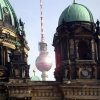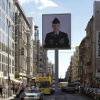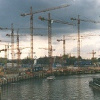BERLIN (GERMANY)
2000.05.18: Pictures from the City
2000.05.18: Checkpoint Charlie, the Wall
2000.05.18: The City and his buildings under reneweal ...
Pictures from the City (2000.05.18)
The history of Berlin consisted of its foundation in the 13th century, and later became the capital of the small country of Prussia. Prussia grew rapidly in the 18th and 19th century, and formed the basis of the German Empire in 1871. Berlin became a major world city, known for its leadership roles in science, the humanities, music, museums, higher education, government, diplomacy and military affairs. During World War II, it was virtually destroyed by bombing, artillery, and ferocious street-by-street fighting. It was split between the victors, and lost its world leadership roles. With the reunification of Germany in 1990, Berlin was restored as a capital and as a major world city. See more ...
Checkpoint C & the Wall (2000.05.18)
Checkpoint Charlie (or "Checkpoint C") was the name given by the Western Allies to the best-known Berlin Wall crossing point between East Berlin and West Berlin, during the Cold War. GDR leader Walter Ulbricht agitated and maneuvered to get the Soviet Union's permission to construct the Berlin Wall in 1961, to stop Eastern Bloc emigration westward through the Soviet border system, preventing escape across the city sector border from East Berlin to West Berlin. Checkpoint Charlie became a symbol of the Cold War, representing the separation of East and West. Soviet and American tanks briefly faced each other at the location during the Berlin Crisis of 1961. After the dissolution of the Eastern Bloc and the reunification of Germany, the building at Checkpoint Charlie became a tourist attraction. It is now located in the Allied Museum in the Dahlem neighborhood of Berlin See more ...
Under Construction (2000.05.18)
Seventy years after the end of the war, Berlin is finally filling the last gaps left by Allied bombs, which destroyed more than two-thirds of the buildings in the city center. Architects say the construction boom offers Berlin a chance to make up for decades of bad planning and mediocre architecture. “This is a new time in Berlin,” says Libeskind, the Polish American architect who designed the Jewish Museum in Berlin and drew up the master plan for the new World Trade Center site in Manhattan. “It’s one of the great cities of the world, and we expect it to compete. We don’t expect it to be some backwater.” See more ...


